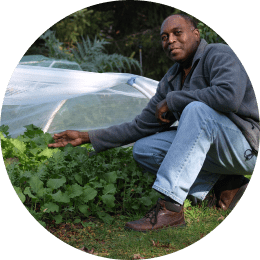The previous entry in this series on raising vegetable transplants examined the seed starting supplies and equipment required to germinate seedlings indoors. Today we’ll look at all the steps involved in growing your own transplants from seed.
Before you touch the first seed, begin by outlining a plan of exactly what you will plant and research the proper time for seed sowing so that the seedlings will be ready to be set out into the garden as soon as the weather is suitable.
Good Seedling Companions
The home gardener will usually sow flats or trays with an assortment of different vegetable plants. So think ahead to prevent a bushy, fast growing tomato seedling from crowding slower growing seedlings such as eggplants that share the same flat.
Also try to plant seeds with similar growth habits and needs together. For example, if you allow collards, kale, broccoli, cauliflower, and kohlrabi to share the same flat they will all grow at about the same height, mature at a similar rate, and can each be transplanted out into the garden at the same time.
This makes it easy for the plants to grow side by side in adjacent cells, and will make your job simpler when it’s time to manage tasks such as adjusting the height of your grow lights, hardening the plants off, and transplanting.
Labeling Your Transplant Seedlings
Another important part of planning involves labeling. Even experienced gardeners may have difficulty distinguishing between seedlings when they first germinate, and if you want to track and compare the performance similar varieties down the road then identification and labeling from the beginning is a must.
I usually plant the same variety of seed across an entire row of a seedling flat. This way I can use the lines on a sheet of paper can represent the rows and simply jot down a single name to identify all the seedlings in a particular row.
When I’ve finished sorting, grouping, and recording the row location of the seeds that I intend to plant I will have created a seedling ID map and simultaneously arranged my seed packets in their planting sequence.
Simple Tip to Using Seed Starting Soil Mixes
Seed starting soil mixtures can be frustrating to work with but you can eliminate many of the hassles by simply moistening the soil before you work with it; this will keep down the amount of dust and make planting and watering much easier. Slowly add water a little at a time and use your hands to mix until the soil is evenly, but very lightly moistened.
If you tried to use dry potting soil in your containers, it would be difficult to fill and compress the soil into the cells. Dry seed starting mixes will also initially repel, rather then absorb water, and it will be almost impossible to water your containers without disturbing the seeds that are planted.
We’re done with the preliminaries, now we can get down to the business of planting our seeds. Fill your flats, trays, or containers with the soil-less mix and press down to firm the medium so that the cells are filled to within half an inch of the top and there are no pockets or air spaces.
Plant, Water, and Wait
Now you can plant your seeds and cover with enough soil mix to place the seeds at their recommended depth. Lightly firm the soil to ensure good contact with the seeds which is important to help them germinate.
Water the containers as needed (from the bottom up if possible) to keep the soil moist but do not allow the soil to completely dry out, or become waterlogged. If you have a germination mat or heating cable place it under the flats to provide gentle bottom heat which will speed seed germination.
Cover the flat with a humidity dome or drape a piece of plastic over the top to conserve moisture and increase humidity levels for your awakening seeds. You’ve done your job, now it’s time for the seeds to do theirs.
While you patiently wait for your seedlings to make their appearance be sure to keep a close eye on them so that you can add water as needed and remove the humidity dome as soon as the seedlings break through the soil’s surface.
Caring for Your Vegetable Transplants
For healthy, stocky seedlings you must move your growing containers to a brightly lit location or under lights as soon as the seeds germinate. The seedlings will require at least 12 – 14 hours of bright light each day, but they also need a period of darkness each day during which they can rest.
Begin feeding your seedlings when they develop their first set of true leaves. Dilute your fertilizer to about half of normal strength and for convenience apply it in solution when you water the flats.
As the plants grow give them regular sessions of seedling strengthening exercise, and before you set them out into the jungle of your backyard garden toughen them up further by gradually reducing the amount of water and fertilizer that they receive, and force them through an outdoor hardening off process.
Finally, follow these seedling transplanting techniques and your plants will go from container to garden without missing a beat.
If everything goes as planned you will have flats of vigorous, well developed vegetable transplants that you raised from seed and prepared to transplant into the garden. Of course things don’t always go as planned so tomorrow I’ll share a few common seed starting problems and discuss what to do when they strike.



One Response
That is a good idea about planting a whole row of flat with the same variety and labeling a line of notebook paper. I always plant a whole cell pack with the same and label with a popsicle stick. Sometimes those sticks get in the way, so I like your idea!